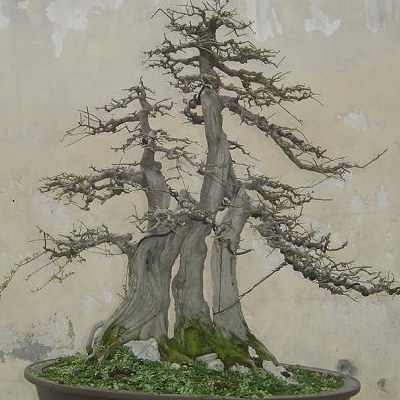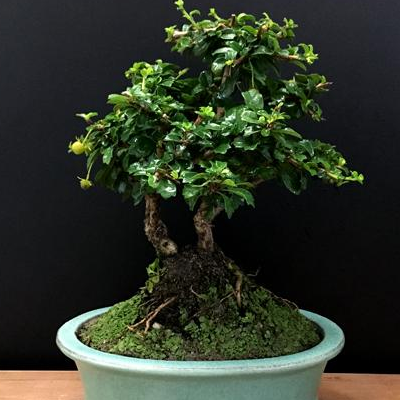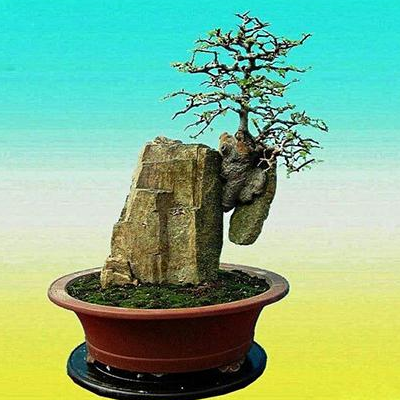What is the price of the method of making tree stump bonsai?
Tree stump bonsai, this is also a kind of bonsai, this stump bonsai is not generally good-looking, what is the production method of tree stump bonsai? What is the price of tree stump bonsai:

The method of making bonsai with tree stump:
1. Panzha method
The shape of the stump bonsai is different, and the bending shape of its branches is also changeable. This is mainly through the technique of banding to adjust and fix the shape. The banding method is mainly divided into wire banding and brown wire banding.
Before banding the trees with metal wire, the trees should be tilted at an angle of 30 °to 40 °and wait for a few months or 1 to 2 years according to different tree species. Next, observe whether the resin and the root bottom are in the same vertical line to ensure the stability of the tree. If the tree does not meet the standard, the tree needs to be replanted. After the tree species have been cultivated, the trunk is curled first, followed by the first-class branches and then the second-class branches. As for the curvature of Panza, if the trunk is thicker, the curvature should be larger, and if the branch growth angle is small, the curvature should be larger, and vice versa.
Brown silk banding method is a difficult method, but it can protect the bark well, so it is widely studied and used by people. For example, Su style bonsai prefer this method. Brown silk banding method is divided into full tie and half tie. The method of full ligation is to bind all the trunk and branches, and it is also the method of banding the trunk and then the branches. Before banding, the front of the tree should be determined first, and then the requirements for branches and leaves should be determined, and the order from bottom to top should be adopted when banding the trunk. The semi-fastening method means that the trunk has been fixed, but only the main branches are fixed.
two。 Pruning
In addition to Panza, tree pruning is also an important method of shaping. The main content of pruning includes the steps of picking heart, picking leaves, picking buds, thinning branches, cutting branches, shrinking branches, carving, injury and so on. In the process of pruning, the mature branches and leaves should be pruned, while the immature branches and leaves should not be pruned prematurely.
Price of tree stump bonsai:
The price of tree stump bonsai is also divided into high and low prices according to different grades of tree species, ranging from a few hundred yuan to tens of thousands of yuan. If you are not familiar with the cultivation of tree stump bonsai, it is recommended to buy low-cost tree stump bonsai to grow. After finding out a certain method, you can buy other higher-grade stump bonsai within the scope of funds.
The production method of tree stump bonsai is introduced here, and the price of this stump bonsai is also very different, so we should pay attention to it.
What is the price of Lingnan bonsai?
Lingnan bonsai, which is a bonsai association that specializes in bonsai, is liked by many people. What is the method of making Lingnan bonsai? What is the price of Lingnan bonsai:
The production method of Lingnan bonsai:
The main results are as follows: (1) to identify the advantages and disadvantages of the tree shape: the shape of the tree is natural and shrinks slowly from bottom to top, and the shape of the base, root and trunk should be matched properly. Most avoid the expansion in the middle and lose the natural proportion. If the roots are exposed on three or four sides and grow on the outside of the soil, the size should be about 1cm.
(2) artistic conception: the key to shaping the whole bonsai should be processed according to its natural form, and strive for simplicity that cannot be forcibly changed. First conceive or draw a sketch according to the shape of the tree and then cut it to maintain the style and unique beauty of the tree.
(3) pole selection: the thickness of the stem is high and low, and the couple is in line with the proportion of the whole bonsai, so as to be harmonious and natural. Classical scars can be cut through the bark of a smooth trunk; about an inch of pruning should be left to form claws more quickly.
(4) whole root: the original fibrous root should be retained and the thick root should be cut short. If the original plate is installed, the coarse root should be truncated accordingly; if it is a square plate, the coarse root can be slightly extended to the left and right to expose the soil, forming a sense of vitality.
(5) pruning: branches located at 1/3 of the trunk must be carefully cut, dense, thick, long and short, and the distance between branches must be symmetrical. If the branches do not meet this requirement, you can cut off all the remaining trunks and let them germinate and grow again.
(6) cultivation: the pruned and shaped stump of a new tree must be cultivated before it germinates and do a good job of promoting root, shortening the time for the stump to leave the soil, sealing, transporting water, fertilizing and so on.
Price of Lingnan bonsai:
(1) Lingnan send sparrow plum boutique pile view large living room courtyard green plant pot, reference price: 48000 yuan / pot.
(2) leaflet red sandalwood pile bonsai Lingnan pie, reference price: 488 yuan / pot.
(3) Lingnan School of bonsai, valuable trees, reference price: 1088 yuan / pot.
Lingnan bonsai production methods and prices are introduced here, this is a long experience!
Making of bonsai with tree stump (picture)
Selection of tree billet
No matter what kind of tree species are selected as the material of the stump bonsai, the billet should be selected first. The choice of tree billet comes from two aspects, namely, the mining of mountain tree billet and the cultivation of saplings, because our requirements for tree stumps are mainly ancient and simple, so we generally choose trees with long age and beautiful shape. there is a certain shape plasticity in the natural growth of the tree billet, if only artificial planting to selection as the material, and then processing, then the modeling time is long and the shape is slow. Therefore, bonsai workers are mostly in the mountain nature to dig wild blanks for processing.
When mining wild billets, it is necessary to take the billets with long age, exuberant growth, strange and strange shape, twists and turns, hanging roots and claws as well. at the same time, attention must be paid to the growth characteristics of the specific billet, determine its mining process and mining time. We believe that it is more appropriate for trees to be excavated after entering the dormant period. for example, from early winter to early spring, attention should be paid to protecting the billet from freezing in winter so that it will not be difficult to survive in the coming year, and it is better to dig when trees sprout in spring. it can not only avoid freezing and increase the difficulty of maintenance and management, but also determine the fate of its skills according to its germination posture. Of course, due to the vast territory of our country and the great difference in climate, it should depend on the climate characteristics of different places.
Because the tree blanks excavated in the mountains are generally older, the primary purpose in the excavation procedure must be to ensure their survival, such as the interception of main or lateral roots, fibrous roots and redundant branches can be determined depending on the tree species. It is usually necessary to retain some of the main styling branches and cut them short to make them sprout, and consider their future shape according to the specific conditions of the billet, but pay attention to leaving more technical tips when intercepting tree species with weak germinating ability. if mining can carry soil in the root as far as possible, if it is not possible to bring soil, then use mud to dip the root with cereal grass or basket, basket packaging and tie up, spread with moss, to protect the billet from excessive water loss during transportation. It is generally better for the billet to be buried deep underground, and after it survives, it will shape and lift the roots year by year, and at the same time pay attention to timely watering, spraying and drainage in dry and waterlogged days, so as to avoid the decay of roots and cadres caused by loss of water or being flooded, so when buried deeply, it is best to raise ridges and build ridges, of course, diseases and insect pests should also be checked and protected in time.
The billet cultivated from an early age can be in its trunk. When the branch grows to a certain extent, it can be sawed and cut, and the root can be planted in the basin after processing, but the soil nutrition in the basin should keep up. In order to make it germinate quickly, it can also be planted on the ground. However, it should be trimmed and mended frequently according to the shape.
The shape of the tree billet
Tree billet modeling must be based on wood conception, wood modeling, especially natural tree stump modeling, must not use regular tree stump modeling method to rigidly apply. The processing and modeling methods of tree billet can be divided into two kinds: flat binding method and pruning method.
(schematic diagram of branch storage, truncation and pruning method)
Pruning method
Pruning is generally carried out after the basic shape, such as flat cutting, selective cutting and so on. But there are also pure pruning methods for modeling, such as Lingnan School bonsai modeling is carried out by purely pruning "storing branches and cutting dry" method. This is influenced by the shape of "chicken claw branch" and "antler branch" in Chinese painting. "storing branches" refers to the cultivation techniques after the selection of technical positions, including the parts and roots that will become tree trunks in the future. "truncation" refers to the truncation or truncation of tree trunks, branches and roots that do not meet the modeling requirements. It is used in the whole process of Lingnan bonsai cultivation, and the tree billet is truncated according to the length, height and height required after excavation. After the new technique is planted and germinated, the technique position is selected, the orientation of the technique is corrected, and when it is stored to the degree of thickness and thickness, it is cut in time according to the length, short, thickness and fineness required by the shape, then the new technique is germinated, and the cutting is carried out again and again, so alternately, branch and truncation is stored until "antlers" and "chicken feet" are formed. However, the pruning methods of other bonsai schools in China are "heavy pruning and light cutting", or "light pruning and heavy cutting", or "heavy pruning and heavy cutting" and so on.
(Brown silk banza)
Sowing method
The sowing method is to shape the stump with brown wire or wire. Brown silk banding belongs to the traditional modeling method of bonsai tree stump, which generally makes a semicircular bend of the trunk or branch, repeating or changing the shape, which is called "Chinese turning". In the bonsai modeling of Sichuan school tree stump, the operation of brown silk is to make silk, turn silk, steal silk, leave knot and so on. Silk twisting is divided into back, winding, hoop, etc.; silk flipping is divided into single-strand upturn, single-strand downward flipping, double-strand downward flipping, double-strand upward flipping; silk stealing is divided into hanging, hanging and stealing. Flat theft, half-bend theft, entanglement theft, etc.; retention knot is divided into living knot, fixed knot, upper knot, lower knot, flat knot, etc.; bends have half-bend, crescent bend, one-inch three-bend, rice bend and so on.
(two winding methods of wire)
Trunk correction method
The flat binding of metal wire is to shape the tree billet with copper wire or lead wire, this method is simple and easy, flexion and extension freely, but there is trouble when it is removed, generally lead wire is used, and the price of copper wire is higher. The thickness of the wire is determined according to the thickness of the trunk and branches, and wires 14 to 20 are more commonly used. When tying, first fix one end of the wire at the base or intersection of the branch, and then wrap it close to the bark. Twist the branch (trunk) while winding, either left or right, and the silk is at a 45-degree angle with the trunk (branch). Force should be uniform, in order to prevent spraining trunk (branch) cambium and bark, if it is easy to peel tree species or rough trunk, you can first use hemp, brown bark and other wrapped branches and then winding.
No matter brown wire or metal wire, sometimes when the trunk is thicker and not easy to bend, the trunk can be opened longitudinally or horizontally to make it easy to bend. The longitudinal opening has the dragon force method and the hob method, the horizontal method has the single cut method or the continuous cut method, and the pry-carry bending method is generally used to tie the big tree in the shape of the tree stump of Sichuan School.
- Prev

How does Fujian tea bonsai shape? how much is the price?
Fujian tea bonsai, this kind of bonsai is a lot of people like farming, this Fujian tea bonsai to grow into a fixed appearance is the need to shape, Fujian tea bonsai how to shape? How much is the price of Fujian tea bonsai: how to shape Fujian tea bonsai: making Fujian tea bonsai
- Next

What kind of stone is used to make stone bonsai?
Stone bonsai, this is a kind of bonsai that many people like. Think that the plant grows on the stone, and it is also a god. What is the method of making stone bonsai? Stone bonsai with what stone: stone bonsai production method: 1. In order to understand the law of plant growth, it is necessary to pay attention to the growth of plants.
Related
- Fuxing push coffee new agricultural production and marketing class: lack of small-scale processing plants
- Jujube rice field leisure farm deep ploughing Yilan for five years to create a space for organic food and play
- Nongyu Farm-A trial of organic papaya for brave women with advanced technology
- Four points for attention in the prevention and control of diseases and insect pests of edible fungi
- How to add nutrient solution to Edible Fungi
- Is there any good way to control edible fungus mites?
- Open Inoculation Technology of Edible Fungi
- Is there any clever way to use fertilizer for edible fungus in winter?
- What agents are used to kill the pathogens of edible fungi in the mushroom shed?
- Rapid drying of Edible Fungi

